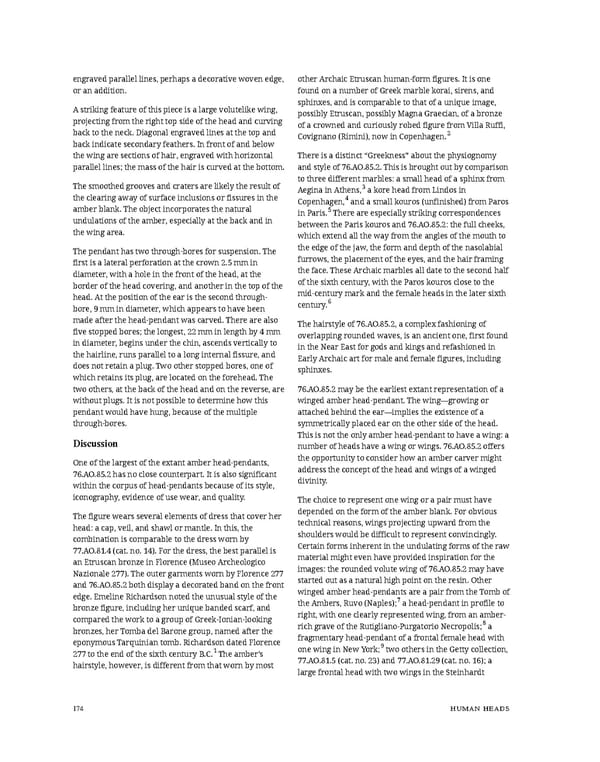engraved parallel lines, perhaps a decorative woven edge, other Archaic Etruscan human-form figures. It is one or an addition. found on a number of Greek marble korai, sirens, and sphinxes, and is comparable to that of a unique image, A striking feature of this piece is a large volutelike wing, possibly Etruscan, possibly Magna Graecian, of a bronze projecting from the right top side of the head and curving of a crowned and curiously robed figure from Villa Ruffi, back to the neck. Diagonal engraved lines at the top and Covignano (Rimini), now in Copenhagen.2 back indicate secondary feathers. In front of and below the wing are sections of hair, engraved with horizontal There is a distinct “Greekness” about the physiognomy parallel lines; the mass of the hair is curved at the bottom. and style of 76.AO.85.2. This is brought out by comparison to three different marbles: a small head of a sphinx from The smoothed grooves and craters are likely the result of Aegina in Athens,3 a kore head from Lindos in the clearing away of surface inclusions or fissures in the Copenhagen,4and a small kouros (unfinished) from Paros amber blank. The object incorporates the natural in Paris.5 There are especially striking correspondences undulations of the amber, especially at the back and in between the Paris kouros and 76.AO.85.2: the full cheeks, the wing area. which extend all the way from the angles of the mouth to The pendant has two through-bores for suspension. The the edge of the jaw, the form and depth of the nasolabial first is a lateral perforation at the crown 2.5 mm in furrows, the placement of the eyes, and the hair framing diameter, with a hole in the front of the head, at the the face. These Archaic marbles all date to the second half border of the head covering, and another in the top of the of the sixth century, with the Paros kouros close to the head. At the position of the ear is the second through- mid-century mark and the female heads in the later sixth century.6 bore, 9 mm in diameter, which appears to have been made after the head-pendant was carved. There are also The hairstyle of 76.AO.85.2, a complex fashioning of five stopped bores; the longest, 22 mm in length by 4 mm overlapping rounded waves, is an ancient one, first found in diameter, begins under the chin, ascends vertically to in the Near East for gods and kings and refashioned in the hairline, runs parallel to a long internal fissure, and Early Archaic art for male and female figures, including does not retain a plug. Two other stopped bores, one of sphinxes. which retains its plug, are located on the forehead. The two others, at the back of the head and on the reverse, are 76.AO.85.2 may be the earliest extant representation of a without plugs. It is not possible to determine how this winged amber head-pendant. The wing—growing or pendant would have hung, because of the multiple attached behind the ear—implies the existence of a through-bores. symmetrically placed ear on the other side of the head. Discussion This is not the only amber head-pendant to have a wing: a number of heads have a wing or wings. 76.AO.85.2 offers One of the largest of the extant amber head-pendants, the opportunity to consider how an amber carver might 76.AO.85.2 has no close counterpart. It is also significant address the concept of the head and wings of a winged within the corpus of head-pendants because of its style, divinity. iconography, evidence of use wear, and quality. The choice to represent one wing or a pair must have The figure wears several elements of dress that cover her depended on the form of the amber blank. For obvious head: a cap, veil, and shawl or mantle. In this, the technical reasons, wings projecting upward from the combination is comparable to the dress worn by shoulders would be difficult to represent convincingly. 77.AO.81.4 (cat. no. 14). For the dress, the best parallel is Certain forms inherent in the undulating forms of the raw an Etruscan bronze in Florence (Museo Archeologico material might even have provided inspiration for the Nazionale 277). The outer garments worn by Florence 277 images: the rounded volute wing of 76.AO.85.2 may have and 76.AO.85.2 both display a decorated band on the front started out as a natural high point on the resin. Other edge. Emeline Richardson noted the unusual style of the winged amber head-pendants are a pair from the Tomb of the Ambers, Ruvo (Naples);7 a head-pendant in profile to bronze figure, including her unique banded scarf, and right, with one clearly represented wing, from an amber- compared the work to a group of Greek-Ionian-looking rich grave of the Rutigliano-Purgatorio Necropolis;8 a bronzes, her Tomba del Barone group, named after the fragmentary head-pendant of a frontal female head with eponymous Tarquinian tomb. Richardson dated Florence one wing in New York;9 two others in the Getty collection, 277 to the end of the sixth century B.C.1 The amber’s hairstyle, however, is different from that worn by most 77.AO.81.5 (cat. no. 23) and 77.AO.81.29 (cat. no. 16); a large frontal head with two wings in the Steinhardt 174 HUMAN HEADS
 Ancient Carved Ambers in the J. Paul Getty Museum Page 183 Page 185
Ancient Carved Ambers in the J. Paul Getty Museum Page 183 Page 185